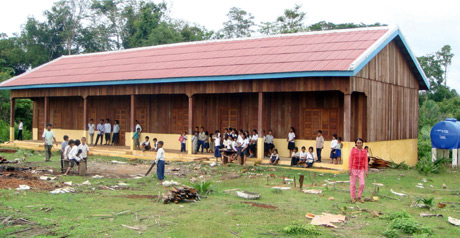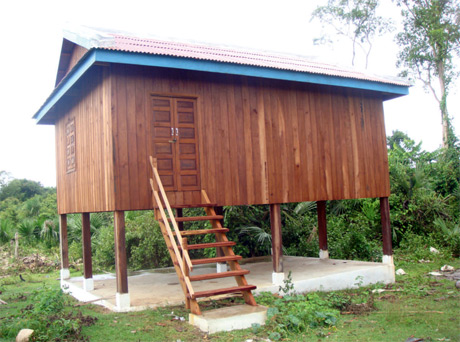Stung Treng school development: at-a-glance
Oxfam Australia’s Stung Treng School Development program is working to provide children with access to education in Stung Treng province, Cambodia. The program is currently building three schools and teacher’s houses in three remote villages: Pha Ao, Tial and Kompong Pang enabling 1,320 children to go to school. The schools will give primary-school aged children better educational facilities, which will improve attendance, increase literacy and help the children build a brighter future for themselves. Footprints Network has committed to funding all three school projects.
In July 2008, we started building the first school and teacher’s house in Pha Ao village, with the help of communities and the local education office. Both are now complete and as 2009 draws to a close, children in Pha Ao are now able to attend school every day. Their new school is equipped with education materials, a pump well, solar panels, water system and toilets. Students have access to clean water and sanitation, allowing them improved health and hygiene. And, now that teachers have their own place, with more privacy and better working conditions, they are more likely to stay in Pha Ao long-term.

The new school is providing 135 children with a stable and ongoing education. To the right, a new 5000L water tank ensures they have clean water.

The new teacher’s house in Pha Ao has already attracted a new teacher to the remote village. The house is well built, and big enough for their entire family.
Foundations for the future
About Pha Ao
Pha Ao village is located 45km west of Stung Treng town, with a population of 462, including 244 women and 102 families. Pha Ao villagers are from the Koy ethnic minority group and most community members are farmers. Only a few families own buffalos or cows, and the poorest families face rice shortages for over four months each year. The younger community members only speak Khmer, and most are unable to read or write.
Ready to go
The new school and teacher’s house in Pha Ao are complete, and the village can now expect positive changes over time, particularly an increase in the number of girls and boys attending school. Improved literacy rates are also expected because children are spending more time at school and are establishing better reading habits.
Before the new school was built, 135 students were taught in one building which had a leaking roof and only makeshift walls made of long leaves. Students now have better facilities, including enough benches and desks to comfortably study and teach. A 5000L water tank makes sure they have clean water to drink, and they also have access to toilets, a new pump-operated well and water system.
Each new school plans to introduce after-school activities, such as vegetable growing, small animal raising, sports activities and drawing contests. These will not only broaden the students’ educational experience and knowledge, but create a fun place to learn.
Community focused
The school and teacher’s house were built with the help of the community, who obtained timber to build the school by liaising with government departments. Community involvement means community members now have the skills, such as quality control and monitoring and evaluation, to lead and manage the building of schools and teacher’s houses, or other community buildings.
The Pho Ao community’s involvement at all stages of this project has increased motivation among parents and students to study. More girls will go to school, as experience has shown that if schools are in a village and children do not have to travel, girls are more likely to attend.
Future projects for education will be easier to implement now that the community has established cooperative relationships with local authorities. The community celebrated the school’s completion with an opening ceremony, generating a sense of community pride and ownership. The building will also be an important venue for adult education classes, and other activities such as traditional and cultural events.
Being resourceful
Oxfam Australia knows it’s not easy building schools in remote areas. Finding affordable materials is a big challenge. In Stung Treng, only two places sell building materials, and they are expensive. This is why communities seek help from local authorities who can source affordable materials, to ensure that building starts on time and stays on budget.
What’s next ?
Your support of Oxfam Australia’s Stung Treng School Development program through The Footprints Network is invaluable to the future of children living in remote villages in Cambodia. Thank you. With the completion of the first school, and plans well under way for the remaining two, these communities living in poverty will soon have access to a fair and essential level of schooling that will allow them to forge a brighter future.
(Update posted 19 October, 2009)
PROJECT FUNDING IS COMPLETE
THANK-YOU! This project has now been fully funded by 9,050
donations
from individuals via The Footprints Network. Now the project work can get
underway.
We'll be back with a report in 2009 and Footprints will continue it's support for Oxfam and fund further Cambodian education/school projects over the next two years.
(Update posted 13 October, 2008)
ORIGINAL PROJECT DESCRIPTION
This project will cover:
Implementation and monitoring the build of a 3-room school plus teacher's house, a set of solar-panels and water tank.
This project includes community involvement tasks such as:
- Mobilizing community to contribute their resources to the school building,
- Negotiating and mobilizing all government management departments and district governor in order to get timber for building schools and other facilities
- Preparing and organizing a bidding process in order to increase the accountability and increase the stakeholders participation and contribution
- Developing the agreement with all stakeholders such as community, local government, and contractor and construction materials suppliers.
Project Outcomes:
This project will promote education in a remote area where around 80% of children are not able to partake in the government-educational system.
Teachers will be dispatched to the villages by the provincial department of Education, Youth and Sports. This strategy encourages the Cambodian government to focus on remote areas lacking equal access to basic services, particularly education.
The building of teacher’s houses, with solar panels, is an important strategy to help retain teachers living in the village and provide a venue for adult education classes.
The community will also be encouraged to use school the as multi-purpose center for traditional and cultural purposes.
Project Background
Pha Ao village is located 45 km west of Stung Treng provincial town, with a population of 462, including 244 females and 102 families. Villagers are predominantly farmers, with few families owning buffalos or cows, and the poorest families facing rice shortages over four months of the year.
The young people speak only Khmer language, and most are unable to read or write. Currently, 135 students are taught in one building which has a leaking roof and only makeshift walls made of leaves.
Part of a larger project
Oxfam has identified 3 small villages in remote regions that all require new and revitalised education facilities. It is a three year project that will see one school built in one village each year. Footprints is providing the funding in 2008/09 for Pha Ao village and intends to support the projects in Tial village (2009/10) and Kampong Pang (2010/11).
In total over the three years, there will be three wooden school buildings (9 rooms), 3 teacher’s houses, 3 water-tanks and three sets of solar panels.
Community Involvement
Community contribution is essential for the success of this project. The community will contribute some materials and labor. The community is responsible for monitoring of work quality of staff and government counterparts. The community will also be involved in the final evaluation and opening ceremony.
Oxfam Australia has been operating in Cambodia since 1982.